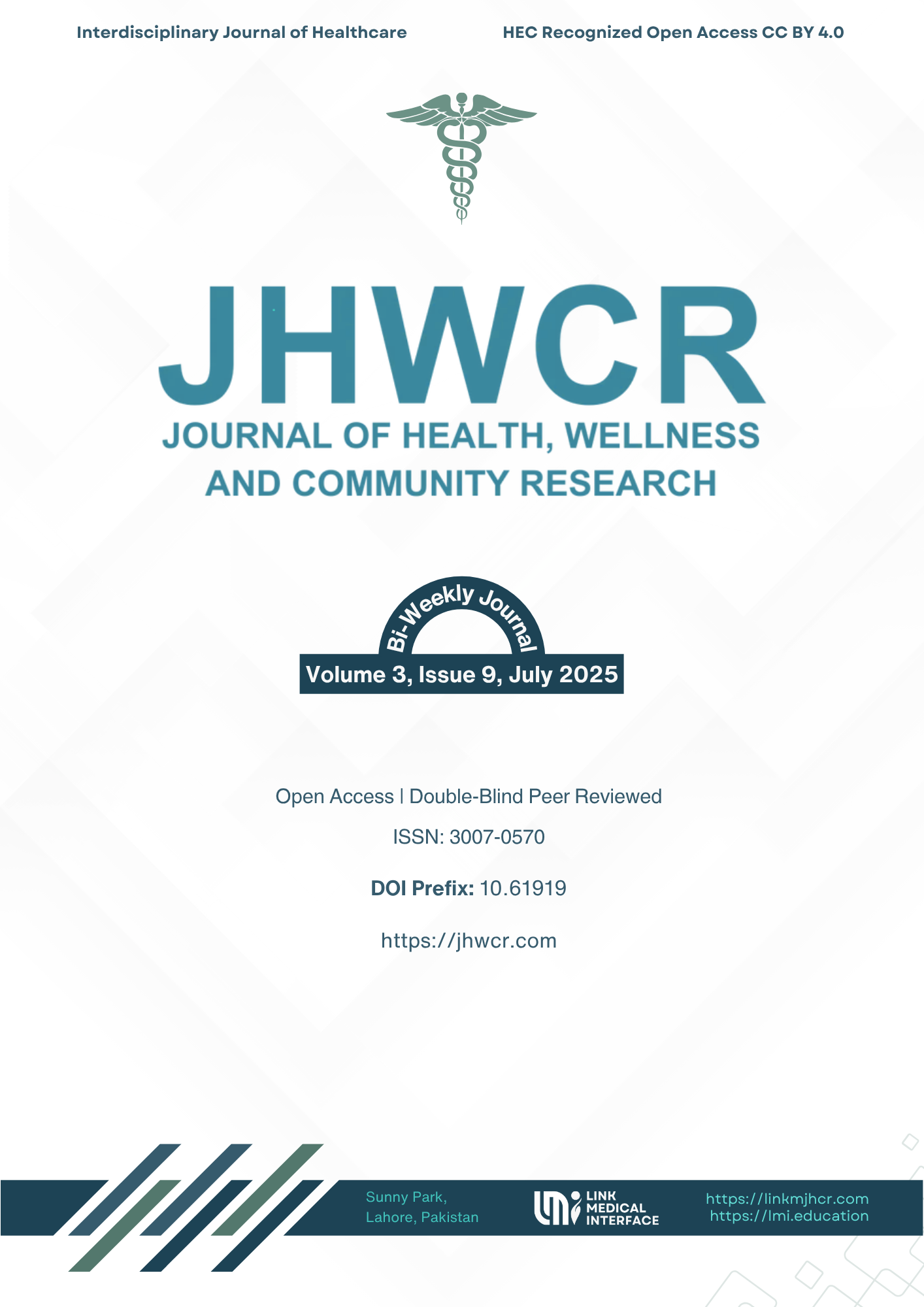Effects of Gong’s Mobilization vs Reverse Distraction Technique in Diabetic Patients with Adhesive Capsulitis
DOI:
https://doi.org/10.61919/jt2wrr15Keywords:
adhesive capsulitis, diabetes mellitus, Gong’s mobilization, reverse distraction, shoulder mobilization, range of motion, functional disabilityAbstract
Background: Adhesive capsulitis, or frozen shoulder, is a painful and debilitating musculoskeletal condition that disproportionately affects individuals with type II diabetes mellitus. The condition severely restricts shoulder range of motion (ROM), limits daily function, and is often more resistant to conservative treatment in diabetic patients due to capsular fibrosis and metabolic changes. Manual therapy techniques such as Gong’s mobilization and reverse distraction have shown promise, but comparative data in diabetic populations are scarce. Objective: To compare the effectiveness of Gong’s mobilization versus reverse distraction technique on pain, ROM, and functional disability in diabetic patients with adhesive capsulitis after four weeks of intervention. Methods: A single-blind, randomized clinical trial was conducted on 20 diabetic patients with unilateral stage 2–3 adhesive capsulitis. Participants were randomly allocated to either Group A (Gong’s mobilization + conventional physical therapy) or Group B (reverse distraction + conventional therapy). Outcome measures included the Shoulder Pain and Disability Index (SPADI), Numeric Pain Rating Scale (NPRS), and goniometric assessment of shoulder ROM. Data were analyzed using paired and independent sample t-tests, with significance set at p<0.05. Results: Both groups showed statistically significant improvements in all outcomes (p<0.05). However, Group A demonstrated significantly greater improvements in SPADI, NPRS, and all ROM parameters (p<0.001). Effect sizes were large for all measures in favor of Gong’s mobilization. Conclusion: While both interventions were effective, Gong’s mobilization was superior to reverse distraction in reducing pain, improving shoulder ROM, and minimizing functional disability in diabetic patients with adhesive capsulitis. Keywords: adhesive capsulitis, diabetes mellitus, Gong’s mobilization, reverse distraction, shoulder mobilization, range of motion, functional disability.
References
1. Aggarwal A, Saxena K, Palekar TJ, Rathi M. Instrument assisted soft tissue mobilization in adhesive capsulitis: A randomized clinical trial. J Bodyw Mov Ther. 2021;26:435–42.
2. Munir A, Ikram M, Rehman SSU. Urdu translation of Shoulder Pain and Disability Index (SPADI) and its validity and reliability on adhesive capsulitis patients. BMC Musculoskelet Disord. 2022;23(1):221.
3. Nakandala P, Nanayakkara I, Wadugodapitiya S, Gawarammana I. The efficacy of physiotherapy interventions in the treatment of adhesive capsulitis: A systematic review. J Back Musculoskelet Rehabil. 2021;34(2):195–205.
4. Kariya G, Dhage P, Deshmukh NS. “Gongs Mobilization” Approach for Frozen Shoulder. Cureus. 2022;14(10).
5. Zreik NH, Malik RA, Charalambous CP. Adhesive capsulitis of the shoulder and diabetes: a meta-analysis of prevalence. Muscles Ligaments Tendons J. 2016;6(1):26.
6. Wang K, Ho V, Hunter-Smith DJ, Beh PS, Smith KM, Weber AB. Risk factors in idiopathic adhesive capsulitis: a case control study. J Shoulder Elbow Surg. 2013;22(7):e24–9.
7. Balci N, Balci MK, Tüzüner S. Shoulder adhesive capsulitis and shoulder range of motion in type II diabetes mellitus: association with diabetic complications. J Diabetes Complications. 1999;13(3):135–40.
8. Neviaser AS, Hannafin JA. Adhesive capsulitis: a review of current treatment. Am J Sports Med. 2010;38(11):2346–56.
9. Babu SKR, Ramalingam V. Effect of Gong's Mobilization Versus Conventional Physiotherapy Among Type II Diabetic Patients With Adhesive Capsulitis. Cureus. 2024;16(6):e63325.
10. Yang S, Park DH, Ahn SH, et al. Prevalence and risk factors of adhesive capsulitis of the shoulder after breast cancer treatment. Support Care Cancer. 2017;25:1317–22.
11. Yang J-L, Chang C-W, Chen S-Y, Wang S-F, Lin J-J. Mobilization techniques in subjects with frozen shoulder syndrome: randomized multiple-treatment trial. Phys Ther. 2007;87(10):1307–15.
12. Tzeng C-Y, Chiang H-Y, Huang C-C, et al. The impact of pre-existing shoulder diseases and traumatic injuries of the shoulder on adhesive capsulitis: a population-based study. Medicine. 2019;98(39):e17204.
13. Hsu KC, Sun CH, Wu YY, et al. Increased risk of adhesive capsulitis among patients with gout: a nationwide population-based matched-cohort study. Int J Rheum Dis. 2018;21(9):1716–22.
14. Farooqui N, Afle GM, Golhar S. Effect of reverse distraction technique versus post-isometric relaxation technique on shoulder ROM, pain and disability in diabetic adhesive capsulitis. IJAR. 2020;6(7):278–88.
15. Modarresi S, Lukacs MJ, Ghodrati M, et al. A systematic review and synthesis of psychometric properties of the NPRS and VAS for use in neck pain. Clin J Pain. 2022;38(2):132–48.
16. Agarwal S, Raza S, Moiz JA, et al. Effects of two different mobilization techniques on pain, ROM and disability in adhesive capsulitis: a comparative study. J Phys Ther Sci. 2016;28(12):3342–9.
17. Challey T, Dutta A, Kalita A, Pyngrope HR. Effectiveness of Gong’s Mobilization Over Myofascial Release Technique in Patients with Adhesive Capsulitis. Int J Life Sci Pharma Res. 2023;13(3):L134–L144.
18. Prasanth S, Sreedharan S, Subbarayalu A. Comparative effect of Gong’s mobilization and Spencer technique to manage frozen shoulder. Physiother Q. 2022;31(3):57–64.
19. Shrestha M, Joshi DD. Effect of gong’s mobilization on pain, ROM and disability in frozen shoulder: A pilot study. Int J Healthc Sci. 2020;8(1):203–6.
20. Amjad F, Asghar H. Comparative effects of gong’s mobilization and mobilization with movement in patients with adhesive capsulitis: a randomized clinical trial. Sci Rep. 2025;15(1):4272.
21. Kubuk BS, Carrasco-Uribarren A, Cabanillas-Barea S, et al. The effects of end-range interventions in the management of primary adhesive capsulitis: a systematic review and meta-analysis. Disabil Rehabil. 2024;46(15):3206–20.
22. Gong W. Effects of dynamic exercise utilizing PNF patterns on the balance of healthy adults. J Phys Ther Sci. 2020;32(4):260–4.
Downloads
Published
Issue
Section
License
Copyright (c) 2025 Summaya Maham Minhas, Rubab Naqvi, Nayab Asif, Rahat Fatima, Maria Umar, Arooj, Aqsa Majeed (Author)

This work is licensed under a Creative Commons Attribution 4.0 International License.


